- Home
- About
- Map
- Trips
- Bringing Boat West
- Migration West
- Solo Motorcycle Ride
- Final Family XC Trip
- Colorado Rockies
- Graduates' XC Trip
- Yosemite & Nevada
- Colorado & Utah
- Best of Utah
- Southern Loop
- Pacific Northwest
- Northern Loop
- Los Angeles to NYC
- East Coast Trips
- Martha's Vineyard
- 1 Week in Quebec
- Southeast Coast
- NH Backpacking
- Martha's Vineyard
- Canadian Maritimes
- Ocracoke Island
- Edisto Island
- First Landing '02
- Hunting Island '02
- Stowe in Winter
- Hunting Island '01
- Lake Placid
- Chesapeake
- Provincetown
- Hunting Island '00
- Acadia in Winter
- Boston Suburbs
- Niagara Falls
- First Landing '99
- Cape Hatteras
- West Coast Trips
- Burning Man
- Utah Off-Roading
- Maui
- Mojave 4WD Course
- Colorado River Rafting
- Bishop & Death Valley
- Kauai
- Yosemite Fall
- Utah Off-Road
- Lost Coast
- Yosemite Valley
- Arizona and New Mexico
- Pescadero & Capitola
- Bishop & Death Valley
- San Diego, Anza Borrego, Joshua Tree
- Carmel
- Death Valley in Fall
- Yosemite in the Fall
- Pacific Northwest
- Utah Off-Roading
- Southern CA Deserts
- Yosemite & Covid
- Lake Powell Covid
- Eastern Sierra & Covid
- Bishop & Death Valley
- Central & SE Oregon
- Mojave Road
- Eastern Sierra
- Trinity Alps
- Tuolumne Meadows
- Lake Powell Boating
- Eastern Sierra
- Yosemite Winter
- Hawaii
- 4WD Eastern Sierra
- 4WD Death Valley +
- Southern CA Deserts
- Christmas in Tahoe
- Yosemite & Pinnacles
- Totality
- Yosemite & Sierra
- Yosemite Christmas
- Yosemite, San Diego
- Yosemite & North CA
- Seattle to Sierra
- Southwest Deserts
- Yosemite & Sierra
- Pacific Northwest
- Yosemite & South CA
- Pacific Northwest
- Northern California
- Southern Alaska
- Vancouver Island
- International Trips
- Index
- Tips
- Books
- Photos/Videos
- Search
- Contact
Portland, OR
Friday, August 13, 2021 - 2:30pm by Lolo
209 miles and 3.5 hours from our last stop - 2 night stay
Travelogue
 Japanese GardenOriginally, I thought Portland would be the easiest destination to find overnight accommodations as there were numerous options throughout the city with reasonable prices. But then it hit us. We have a Yakima rooftop box on top of our 4 Runner, making us over 7.5 feet high - too tall for parking garages, which was what most Portland hotels offered. We didn’t want to park a vehicle with most of our belongings in it on the streets of Portland, so we started to panic over whether this was feasible.
Japanese GardenOriginally, I thought Portland would be the easiest destination to find overnight accommodations as there were numerous options throughout the city with reasonable prices. But then it hit us. We have a Yakima rooftop box on top of our 4 Runner, making us over 7.5 feet high - too tall for parking garages, which was what most Portland hotels offered. We didn’t want to park a vehicle with most of our belongings in it on the streets of Portland, so we started to panic over whether this was feasible.
I then worked things backwards and went on Booking.com looking for places on the outskirts of the city with free parking. This led me to what seemed to be the ideal option - a studio apartment in the Nob Hill section of Portland in walking distance to Washington Park, with free street parking. The photos of the apartment were lovely and all the reviews raved about its excellent location and proximity to great restaurants.
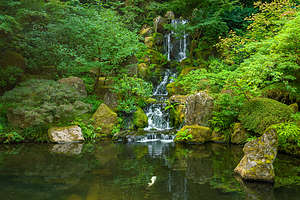 Japanese GardenThe price seemed really reasonable too. We were excited, or at least until we saw that after all the fees were added on, the price nearly doubled. I was crestfallen, but we were in too deep, so we decided to just go for it. A few nights of camping would amortize the amount we were spending for sleeping each night.
Japanese GardenThe price seemed really reasonable too. We were excited, or at least until we saw that after all the fees were added on, the price nearly doubled. I was crestfallen, but we were in too deep, so we decided to just go for it. A few nights of camping would amortize the amount we were spending for sleeping each night.
Since we couldn’t check in our rental until 4:00, we decided to head directly to Washington Park, Portland’s crown jewel. Every city needs its monumental green space. New York has Central Park, San Francisco its Golden Gate Park, etc. Portland has its Washington Park, encompassing 130 acres of forest, a Japanese Garden, the international Rose Test Garden, a zoo, and more. It was modeled on European parks, with winding drives, fountains, statuary, and formal gardens. It was lovely.
 International Rose GardenWe started our visit at the Japanese Garden where we were fortunate enough to find nearby parking. There was a significant crowd waiting to buy tickets. The Gardens are actually five separate gardens linked by winding paths:a Tea Garden, a Strolling Pond Garden, a Natural Garden, a Flat Garden, and a Sand and Stone Garden.
International Rose GardenWe started our visit at the Japanese Garden where we were fortunate enough to find nearby parking. There was a significant crowd waiting to buy tickets. The Gardens are actually five separate gardens linked by winding paths:a Tea Garden, a Strolling Pond Garden, a Natural Garden, a Flat Garden, and a Sand and Stone Garden.
They were designed in the 1960s by Takuma Tono, a renowned Japanese landscape architect, and recognized by the Japanese ambassador to the United States as “the most beautiful and authentic Japanese garden in the world outside of Japan.”
 Portland ZooTickets were $18.95 for adults and $16.25 for Seniors (65+).
Portland ZooTickets were $18.95 for adults and $16.25 for Seniors (65+).
From there we walked across the road to the International Test Rose Garden, where there are 4.5 acres of beautiful formal rose gardens with over 6,800 rose bushes representing 557 different varieties. It is one of 24 gardens in the U.S. that test new rose varieties for vigor, disease resistance, color, flower production, and fragrance.
From the garden there can on clear days be a wonderful view of Portland with Mount Hood in the background. Unfortunately, the smoke from various wildfires obscured the mountain.
I forgot to mention that Portland was experiencing a heatwave and it was well into the mid-90s, so our next activity was probably not the wisest. We decided to go to Oregon Zoo all the way at the other side of Washington Park, but rather than take the free shuttle, we thought it might be nice to see the whole park by walking there.
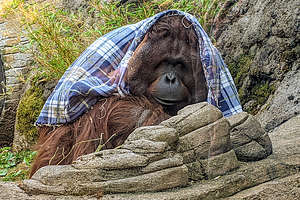 Portland ZooThe walk there was a bit more intense than we anticipated. Rather than winding paths through green areas and play areas, such as in Central or Golden Gate Parks, we were hiking for 3 miles or so up and down steep dirt paths through a pretty thick forest.
Portland ZooThe walk there was a bit more intense than we anticipated. Rather than winding paths through green areas and play areas, such as in Central or Golden Gate Parks, we were hiking for 3 miles or so up and down steep dirt paths through a pretty thick forest.
Finally, we arrived at the zoo, which was practically empty, due to the heat. We knew animal viewing would not be that great because they would all be hiding in the shade and not moving, but since we were here, we decided to buy tickets and go anyway.
The zoo is arranged in five areas that range across different continents and ecosystems: Great Northwest, Elephant Lands, Africa, Primate Forest and Discovery Zone. Within each zone you’ll find animals and habitats such as Africa Savanna or Polar Passage that recreate the habitats of specific animals.
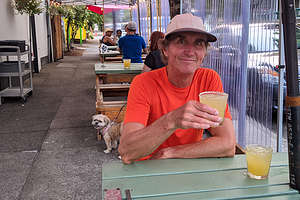 Herb enjoying his $5 MargaritaWe did get to see see elephants, primates, giraffes, bears, flamingos, eagles, and much more,
Herb enjoying his $5 MargaritaWe did get to see see elephants, primates, giraffes, bears, flamingos, eagles, and much more,
but It was a bit sad, as the animals definitely were not active and did not look particularly happy or comfortable. We weren’t either, so we took the free park shuttle back to our car by the Japanese Garden and drove over to Lovejoy Avenue about a mile and a half away to check into our home for the next two nights.
We had a lovely little studio apartment in the fashionable Nob Hill neighborhood, known for its ornate Victorian houses, tree-lined streets, and a thriving dining scene.
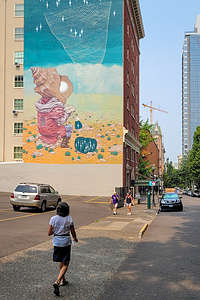 Walking tour of PortlandThat evening we strolled over to NW 23rd Avenue, the trendy main drag with tons of restaurants, bars, and shops. We didn’t go too far before being drawn in by the bustling crowd at Santa Fe Taqueria and its $5 margaritas enticing sign. We sat at an outdoor table, had a delicious meal and listened to live music from the corner across the street.
Walking tour of PortlandThat evening we strolled over to NW 23rd Avenue, the trendy main drag with tons of restaurants, bars, and shops. We didn’t go too far before being drawn in by the bustling crowd at Santa Fe Taqueria and its $5 margaritas enticing sign. We sat at an outdoor table, had a delicious meal and listened to live music from the corner across the street.
The next day was our big walking tour of Portland, so we set off with rather an ambitious itinerary ahead of us.
First stop, the famous Powell’s City of Books. “City” of books was not an overstatement. This place was incredible, taking up an entire block square and three stories tall. Its miles of bookshelves contained new, used, and out-of-print books, and I dare anyone to stump them in having a book in their vast collection. You could literally spend days browsing their shelves and only making a dent in them.
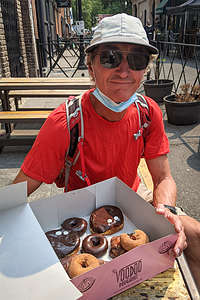 Herb enjoying his giant box of Voodoo DonutsNext, we moved on to a less cerebral activity - Voodoo Donuts, the iconic and highly popular donut shop that refers to its bakers as artists. Needless to say, there was a very long line wrapping around the corner, but to my surprise, Herb had no hesitation waiting - that man loves a good pastry.
Herb enjoying his giant box of Voodoo DonutsNext, we moved on to a less cerebral activity - Voodoo Donuts, the iconic and highly popular donut shop that refers to its bakers as artists. Needless to say, there was a very long line wrapping around the corner, but to my surprise, Herb had no hesitation waiting - that man loves a good pastry.
The menu was overwhelming, with over 50 cleverly named, mouth watering choices. We were quite conservative in both quantity and content. I talked Herb down from a dozen to two each of Portland Cream, Apple Fritter, Cinnamon Sugar Cake, and Double Chocolate.
They were packed in a pink box the size of Delaware that we now had to cart around the city on our tour. Herb took one for the team and ate one of the giant Apple Fritters and a Portland Cream immediately upon exiting the store and I joined him in his efforts with one of the Double Chocolates.
 Lan Zu Chinese GardenDown to 5, we asked for some bags instead of the box and stuffed them in our backpacks, discarding the enormous pink box. With temps in the 90s, I was a bit worried about what the state of my other Double Chocolate would be at the end of the day.
Lan Zu Chinese GardenDown to 5, we asked for some bags instead of the box and stuffed them in our backpacks, discarding the enormous pink box. With temps in the 90s, I was a bit worried about what the state of my other Double Chocolate would be at the end of the day.
We forged on. Next stop, the Lan Zu Chinese Garden, a replica of a formal garden built in the style of the Ming Dynasty. Its creation was a joint effort between craftspeople in Portland and its Chinese sister city. It is the largest traditional Chinese garden in the U.S.
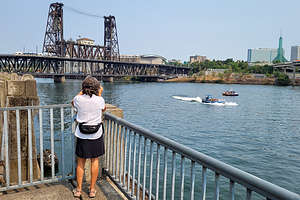 Portland's Steel BridgeThe peaceful setting served as a sharp contrast to the noisy streets and higher buildings of downtown Portland that surrounded it - an oasis in a sea of modern urban life.
Portland's Steel BridgeThe peaceful setting served as a sharp contrast to the noisy streets and higher buildings of downtown Portland that surrounded it - an oasis in a sea of modern urban life.
The landscaping, ponds, and buildings were beautiful and if it weren’t for my concerns about my Double Chocolate donut melting in my backpack, I would have been in a state of perfect peace and harmony. .
After leaving the Chinese Gardens we headed to the Tom McCall Waterfront Park. A friend of mine who recently lived in Portland warned us that this was often the location for Proud Boy / Antifa protests, so to be wary. Fortunately, today there were no protesters to be found. Just children cooling off in the fountains. I was very tempted to take a run through them myself.
 Portland Art MuseumWe ended our tour at the Portland Art Museum, which I would have to say wasn’t my favorite art museum. Maybe we were just hot and tired - we had already walked over 8 miles, and were a bit overwhelmed by the degree of homelessness in the city, which is so very sad.
Portland Art MuseumWe ended our tour at the Portland Art Museum, which I would have to say wasn’t my favorite art museum. Maybe we were just hot and tired - we had already walked over 8 miles, and were a bit overwhelmed by the degree of homelessness in the city, which is so very sad.
We headed back to our apartment for a well-needed nap, and maybe a donut.
That evening, we headed back out to NW 23rd Avenue to people watch and have dinner. This time we ate at Thai Bloom! (that ! is not a typo - it is actually part of the restaurant’s name) where we had a delicious dinner and my first ever Tamarind Margarita. It will not be my last.
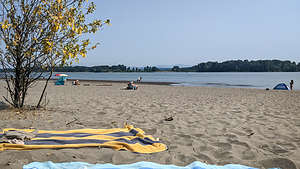 Sauvie IslandAfter the last two day’s aggressive march though Portland trying to see everything, we needed some down time, so after checking out of our rental, we headed to Sauvie Island, ten miles northwest of Portland at the confluence of the Willamette and Columbia Rivers, reach via the Sauvie Island Bridge on Highway 30.
Sauvie IslandAfter the last two day’s aggressive march though Portland trying to see everything, we needed some down time, so after checking out of our rental, we headed to Sauvie Island, ten miles northwest of Portland at the confluence of the Willamette and Columbia Rivers, reach via the Sauvie Island Bridge on Highway 30.
The southern half of the island is predominantly rural farmland, while the northern half is a wildlife refuge with sandy beaches along the northeastern side of the island. Parking permits are required in all wildlife areas on the island (which includes the beaches). Daily permits are $10 and can be purchased at several convenience stores on the island.
The island was lovely and we saw many bicyclists out enjoying a Sunday morning ride along its 12-mile “hill-less” loop.
 The Floating SaucerWe were early enough to easily find a parking spot along a lovely sandy beach, where we spent the day relaxing, reading, and dipping ourselves in the Columbia River to get cool. It was a well-needed down day.
The Floating SaucerWe were early enough to easily find a parking spot along a lovely sandy beach, where we spent the day relaxing, reading, and dipping ourselves in the Columbia River to get cool. It was a well-needed down day.
I did take a short stroll down the beach in search of a geocache that sounded very interesting. It was called "floating saucer." As my phone told me I was getting closer, I glanced towards the edge of the woods where I found a very surprising sight - a large submarine / flying saucer like object colorfully painted all over with graffiti.
A nearby signed gave its history: This 31-foot paddle wheel boat was built in 1973 in Hubbard, Oregon, by an engineer named Richard Ensign. It took him two years and cost $10,000. It could sleep 12 people and had a wood stove. It was launched on the Willamette River, went through the locks at Willamette Falls, and was front page of the Oregonian. It was dubbed the "floating saucer." It mostly likely was left here by the February 1996 flood.
I ever did find the geocache, but I am very glad that the search for it brought me here. Who would have thought?
Now onto more action.
- ‹ previous
- 4 of 8
- next ›
Portland location map in "high definition"
Javascript is required to view this map.
